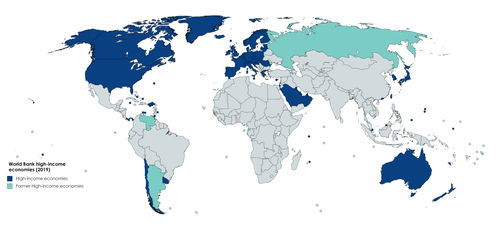World Bank high-income economy
A high-income economy is defined by the World Bank as a country with a gross national income per capita of US$12,536 or more in 2019, calculated using the Atlas method.[1] While the term "high-income" is often used interchangeably with "First World" and "developed country", the technical definitions of these terms differ. The term "first world" commonly refers to countries that aligned themselves with the U.S. and NATO during the Cold War. Several institutions, such as the Central Intelligence Agency (CIA) or International Monetary Fund (IMF), take factors other than high per capita income into account when classifying countries as "developed" or "advanced economies". According to the United Nations, for example, some high-income countries may also be developing countries. The GCC countries, for example, are classified as developing high-income countries. Thus, a high-income country may be classified as either developed or developing.[2] Although the Holy See is a sovereign state, it is not classified by the World Bank under this definition.

List of high-income economies (as of 2021 fiscal year)
According to the World Bank the following 80 countries (including territories) are classified as "high-income economies".[1] In brackets the year(s) during which they held such classification. As of the 2021 fiscal year, high-income economies are those that had a GNI per capita of $12,535 or more in 2019.[1]
High income UN members
|
|
|
|
High income non-UN members
|
|
|
|
Former high-income economies
The year(s) during which they held such classification is/are shown in paranthesis.[3]
|
|
|
a Between 1994 and 2009, as a part of the ![]()
Historical thresholds
The high-income threshold was originally set in 1989 at US$6,000 in 1987 prices. Thresholds for subsequent years were adjusted taking into account the average inflation in the G-5 countries (the United States, the United Kingdom, Japan, Germany and France), and from 2001, that of Japan, the United Kingdom, the United States and the eurozone.[4] Thus, the thresholds remain constant in real terms over time.[3] To ensure no country falls right on the threshold, country data are rounded to the nearest 10 and income thresholds are rounded to the nearest 5.[5]
The following table shows the high-income threshold from 1987 onwards. Countries with a GNI per capita (calculated using the Atlas method) above this threshold are classified by the World Bank as "high-income economies".[3]
| Year | GNI per capita (US$) | Date of classification |
|---|---|---|
| 1987 | 6,000 | October 2, 1988 |
| 1988 | 6,000 | September 13, 1989 |
| 1989 | 6,000 | August 29, 1990 |
| 1990 | 7,620 | September 11, 1991 |
| 1991 | 7,910 | August 24, 1992 |
| 1992 | 8,355 | September 9, 1993 |
| 1993 | 8,625 | September 2, 1994 |
| 1994 | 8,955 | June 8, 1995 |
| 1995 | 9,385 | June 3, 1996 |
| 1996 | 9,645 | July 1, 1997 |
| 1997 | 9,655 | July 1, 1998 |
| 1998 | 9,360 | July 1, 1999 |
| 1999 | 9,265 | July 1, 2000 |
| 2000 | 9,265 | July 1, 2001 |
| 2001 | 9,205 | July 1, 2002 |
| 2002 | 9,075 | July 1, 2003 |
| 2003 | 9,385 | July 1, 2004 |
| 2004 | 10,065 | July 1, 2005 |
| 2005 | 10,725 | July 1, 2006 |
| 2006 | 11,115 | July 1, 2007 |
| 2007 | 11,455 | July 1, 2008 |
| 2008 | 11,905 | July 1, 2009 |
| 2009 | 12,195 | July 1, 2010 |
| 2010 | 12,275 | July 1, 2011 |
| 2011 | 12,475 | July 1, 2012 |
| 2012 | 12,615 | July 1, 2013 |
| 2013 | 12,745 | July 1, 2014 |
| 2014 | 12,735 | July 1, 2015 |
| 2015 | 12,475 | July 1, 2016 |
| 2016 | 12,236 | July 1, 2017 |
| 2017 | 12,056 | July 1, 2018 |
| 2018 | 12,376 | July 1, 2019 |
| 2019 | 12,536 | July 1, 2020 |
See also
- High income OECD country
- Developed country
- Developing country
- Least developed country
- North–South divide
References
- Country and Lending Groups. World Bank. Accessed on July 1, 2020.
- "UN. (2005). UNCTAD Handbook of Statistics" (PDF). Retrieved 2007-07-09.
- "comparison with the previous fiscal year". World Bank. Retrieved 2018-04-22.
- The Atlas Method, World Bank.
- "The Interim Measure for calculating financial contributions: review of cut-off points defining capacity-to-pay groups" (PDF). Agenda item 4. 2008-06-04.